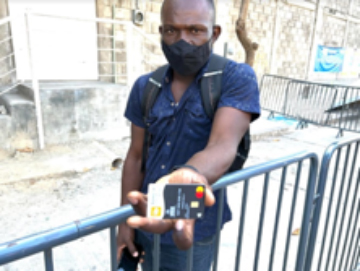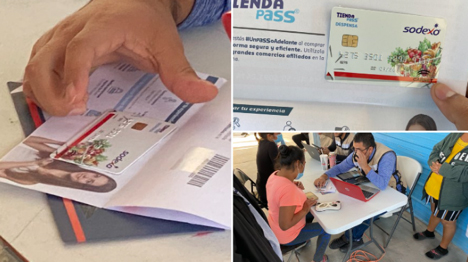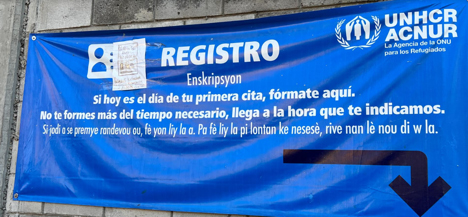AUSTIN, Texas — Early on in America’s historic border crisis, now entering its fourth record-smashing year, some Republican lawmakers named a significant enabling culprit other than the usual Mexican cartel smugglers. They named the U.S. taxpayer-funded United Nations as essentially a co-smuggler after seeing my reports that the UN was handing out debit cards and cash vouchers to aspiring illegal border crossers on their way north.
One outraged group of 21 border-security-minded lawmakers even pitched a bill that would require the United States, the UN’s largest donor, to turn off the taxpayer money spigot. H.R. 6155 never caught fire, though, in no small part because “fact checks” claiming to debunk other reports like mine in the conservative press dissuaded broader media interest and left the American public in the dark.



But now the UN’s 2024 update to the “Regional Refugee and Migrant Response Plan” (RMRP for short), a planning and budget document for handing out nearly $1.6 billion in 17 Latin America countries, can cast a broad confirming light on the cash giveaways and much more aid for 2024 ahead — with the helping hands of 248 named non-governmental organizations. Despite the RMRP plan title naming Venezuelans as recipients of this aid operation, the document’s fine print (footnote on p. 14 and paragraph on p. 43, for instance) says the largesse goes to “all nationalities” and “multiple other nationalities”.
The documents clear up any mystery about what the UN and NGOs are doing on the migrant trails and leave no room for supposedly debunking “fact checks”.
In a nutshell, the UN and its advocacy partners are planning to spread $372 million in “Cash and Voucher Assistance (CVA)”, and “Multipurpose Cash Assistance (MCA)” to some 624,000 immigrants in-transit to the United States during 2024. That money is most often handed out, other UN documents show, as pre-paid, rechargeable debit cards, but also hard “cash in envelopes”, bank transfers, and mobile transfers the U.S. border-bound travelers can use for whatever they want.
The $372 million in planned cash giveaways to the 624,000 immigrants moving north and illegally crossing national borders “represents a significantly greater share of the financial requirements” for 2024, the RMRP says, but it is still only one part of much broader UN hemisphere-wide vision that aims to spend $1.59 billion assisting about three million people in 17 countries who emigrated from their home nations. Most will be “in-destination” recipients already supposedly settled in third countries, albeit in declining numbers, but a rising share of cash will go to the spiking numbers of “in-transit” immigrants launching journeys from those accommodating countries north to the United States.
Without distinction, both populations get access to UN cash but also “humanitarian transportation”, shelter, food, legal advice, personal hygiene products, health care, and “protection” against threats like human smuggling, and much more besides cash in envelopes or debit cards.
The cash handouts will be in the mix during 2024 as the UN and its private partners incorporate an “increased use of CVA” in, for instance, the $184 million it plans to provide 1.2 million people, $122 million for rent support and also “temporary collective shelter” for 473,000 people, and $25.8 million for “humanitarian transportation” to 129,000 people crossing borders. There’ll also be “expanded use of multi-purpose cash” for those claiming “gender-based violence”.
The UN’s 2024 Game Plan
The 130-page UN-spearheaded RMRP 2024 update went public in December and is readily accessible online, as is the original 2023-2024 plan it revises — sharply upward. It is the latest since the United Nations High Commissioner for Refugees and the UN’s International Organization for Migration started the program in 2018, originally for Venezuelans but now open to anyone in 17 nations of Latin America and the Caribbean. (For the complete list of involved groups, see p. 268, here, and explore their activities further with this handy interactive tool).
Some 57 international organizations would manage the handouts of $273 million, while 132 “national NGOs” and “civil service organizations” would handle $70 million in aid. Fifteen UN agencies would get the lion’s share at $1.2 billion.
The NGOs actively participated in crafting the RMRP 2024 Update, which amends a 2023-2024 plan released back in 2022 that at the time foresaw a decline in illegal immigration after 2023. It increased, instead.

“Country-level projections of in-transit movements for populations moving north through Central America and Mexico have been revised sharply upwards,” p. 44 explains in updating the 2024 RMRP update.
The reasons given include factors like “xenophobia” leading resettled migrants to leave for the United States. It does, finally, tag the real culprit: U.S. policies that created “newly established opportunities for regular pathways to move to the United States of America” for those who could make their way to northern Mexico.
The document makes clear in writing that the UN and these partners know their endeavor aids, abets, and makes possible the “onward movement” of immigrants who intend to illegally cross borders, especially to get into the United States.
None of them care. Twenty new groups joined the UN endeavor for 2024 for a total of 248.
Their plan frequently acknowledges the illegality, saying for instance, that one in three of the Venezuelan migrants the UN aims to help are in “irregular situations", including those “who have crossed international borders without complying with all the legal and administrative requirements for entry and may not have the required documentation to do so”, as well as visa overstayers. The original 2023-2024 plan even spelled out that “special attention will be given to the use of [cash and voucher assistance] for in-transit populations, including the need for comprehensive solutions throughout the journey”.
The only expression of apparent concern about supporting people clearly intending to break U.S. law shows up on a page depicting a map with the thin red line of a migration route leading to the U.S. border at about El Paso. Someone took the trouble to add a footnote on that page noting that the map “does not imply official endorsement or acceptance by the UN”.


Why hand out hundreds of millions of dollars as cash and services to hundreds of thousands planning to illegally follow that red line through UN member states, to include crossing the US border, when those nations don’t like or want it and must bear the political controversies of it?
“To support access to asylum procedures, migratory regularization activities, and socio-economic integration”, the plan says.
The money handout program “has taken on increasing importance”, it explains elsewhere, because it gives growing numbers of immigrants “the flexibility to cover their expenses and needs they deem most urgent, increasing their dignity and autonomy”.
Where It’ll Be Doled Out
Over the past three years, I have visited UN waystations featuring long lines of U.S.-bound immigrants applying for aid from clipboard-wielding workers handing out cash cards and other goodies, from Reynosa and Monterrey in the north of Mexico to Tapachula in the far south. But the waystations also appear everywhere along the trails much farther south.
The RMRP plan calls for distributing most of the cash, cash equivalents, and vouchers to migrants in Colombia and Ecuador, which are launch pads that sent 450,000 people through the Darian Gap jungle passage in Panama. The plan calls for 24 NGO partners to give money to 95,000 in Colombia and 59,000 in Mexico.
Some of the so-called transportation assistance is for local cab rides to stores or doctor appointments. But the UN agencies also know that aid will facilitate “increased onward movements” between countries of the “in-transit population” for 105,000 immigrants in Colombia, 25,000 in Brazil, 13,000 in Panama, and 3,700 in Mexico, to name a few places.
Likewise for “shelter”, $27.5 million is earmarked for 161,000 travelers in Colombia, $22.5 million for 179,000 in Ecuador, $18 million for 165,000 in Peru, and $4.3 million to help 33,000 in Mexico.
Political Fight or Flight
In years one and two of the historic mass migration crisis that President Biden’s let-them-all-in policies triggered, Republicans in the U.S. House of Representatives spoiled for a political fight over UN and NGO activity along the migrant routes because it was funded largely and ironically by the United States. And not just them. In December 2022, Texas Gov. Greg Abbott wrote Attorney General Ken Paxton asking him to investigate whether non-governmental organizations unlawfully assisted mass border crossings that overwhelmed the El Paso region.
Recent Congressional Research Service reporting reminds us that they had some legitimate grounds to complain; the United States has been the largest financial contributor to UN entities since the UN was established in 1945. Congress and the executive branch play key roles; Congress appropriates U.S. funding, while the executive branch shapes where the money will go through the State Department and the U.S. Mission to the United Nations in New York City.
Complaints, questions, and proposed legislation about the UN’s role in all of this may have gone cold, but as the latest RMRP plan reveals, the world body is as hot on the trail as ever.
Note: A version of this article ran as an op-ed in the New York Post on January 22.
